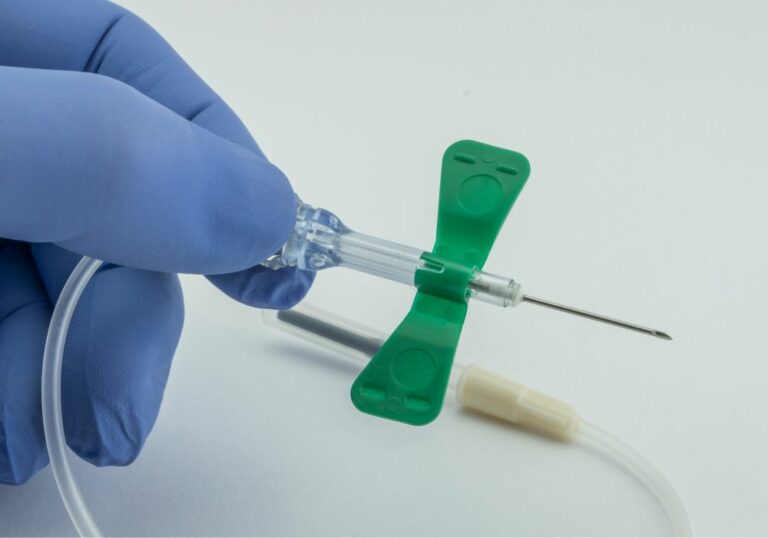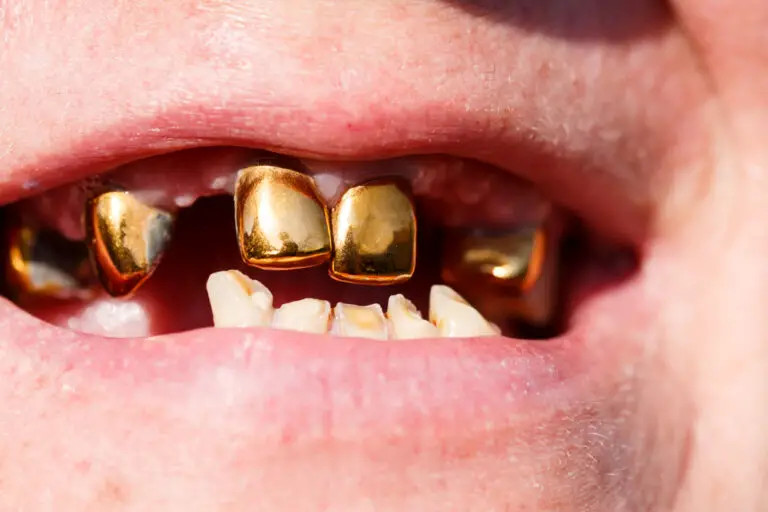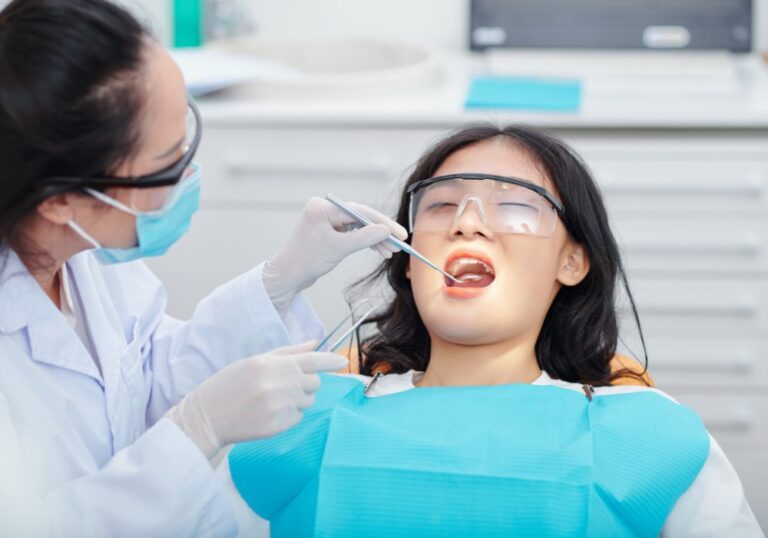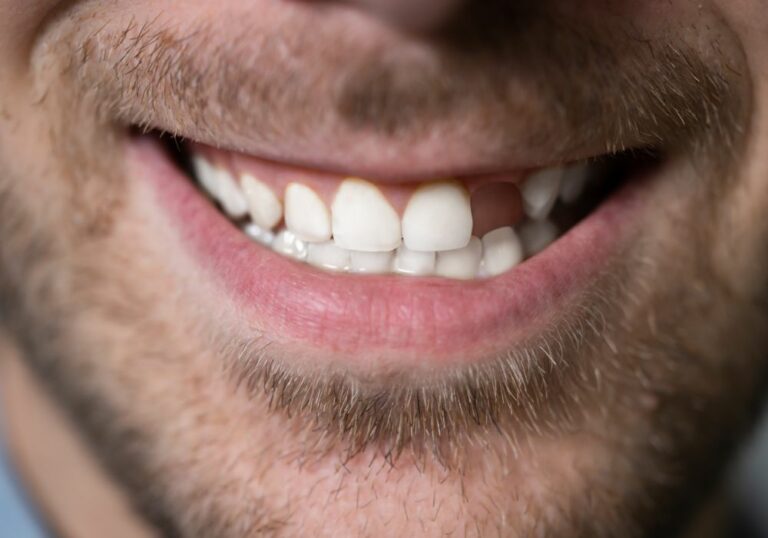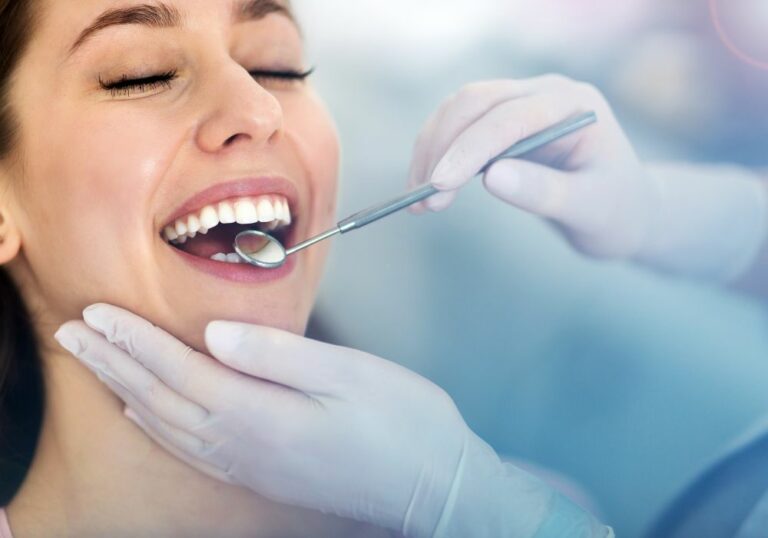Getting braces is an exciting milestone! You’re looking forward to having a straight, beautiful smile by the time treatment is over. But with a mouthful of brackets and wires, keeping your teeth clean requires extra care and diligence. You may wonder if you can get by with brushing just once a day. Unfortunately, that is ineffective for people with braces. Here’s a more in-depth look at why brushing after every meal is so crucial when you have orthodontic appliances.
Why Frequent Brushing is Essential With Braces
When you get braces, the metal brackets and archwires create lots of new nooks and crannies for food particles and plaque to accumulate. Plaque is a sticky film of bacteria that forms on teeth. The brackets and wires make it easier for plaque to build up and hide. Without regular brushing, this bacteria growth can lead to some harmful consequences for your oral health:
- Tooth decay – The plaque around braces releases acid that eats away at tooth enamel. This can create cavities – permanently damaged spots on your teeth. Decay near brackets is especially concerning since that weakens the tooth structure just underneath the bracket’s bonding spot. Untreated decay results inFillings, root canals, crowns, or tooth extractions may eventually be needed.
- Gum disease – Plaque that sits below the gumline causes swollen, tender gums that are prone to bleeding. This inflammation is called gingivitis. It can advance to periodontitis where gums pull away from teeth, creating pockets that become infected. In severe cases, the bone holding teeth also erodes. Without treatment, loose teeth may need to be extracted.
- White spots – Before a cavity forms, the early stages of decay show up as dull, chalky white spots on teeth near brackets. These are permanently etched into the enamel if acid erodes an area faster than saliva can remineralize it. Diligent brushing helps prevent these unsightly spots.
- Bad breath – Bacteria accumulation results in chronic bad breath. Food particles and bacteria cause unpleasant odors whenever you open your mouth. Thorough brushing and cleaning between teeth helps freshen breath.
- Stained teeth – Without brushing off pigments promptly, foods and drinks like coffee, tea, soda, and berries can permanently stain the enamel around braces brackets. These drinks contain tannins, chromogens, and polyphenols that adhere to the surface.
- Prolonged treatment time – Poor oral hygiene leads to plaque accumulation, decay, gum inflammation, and damage that actually extends how long braces must be worn. Food trapped by braces also impedes proper tooth movement. This delays achieving your desired smile.
Research shows that people wearing fixed braces need to brush for 3-4 full minutes after meals – not just once daily – to adequately control plaque and avoid damage. Why is more frequent brushing so essential? Let’s look closer.
The Impact of Infrequent Brushing With Braces
Brushing just once a day with braces leaves far too much time between brushing sessions for plaque to thrive. Here is what happens:
- Food debris gets left behind – After eating with braces, some particles inevitably get stuck. They cling to brackets, wires, ligatures, and other appliances. Just rinsing can’t fully dislodge this debris so it sits there all day, providing nourishment for plaque bacteria.
- Plaque flourishes – Without brushing after every meal, plaque accumulates rapidly both above and below the gumline. In 24 hours, what starts as a thin biofilm can multiply and thicken into a plaque full of bacteria colonies.
- Acids aren’t neutralized – Bacteria produce acids as a byproduct that demineralize and dissolve enamel. After consuming sugars and carbohydrates from foods or drinks, acids increase. Frequent brushing neutralizes these acids before substantial damage occurs.
- Gums become inflamed – Plaque that spreads below the gumline causes gingivitis and bleeding. The longer plaque sits there, the more irritated the gums become. Brushing after meals disrupts plaque before it gets a foothold.
- Stains set in – Pigmented foods and drinks leave behind tannins and staining compounds. Without quick brushing, these have time to penetrate and discolor the enamel. It’s harder to then brush away the set-in stains.
With braces, you simply miss too many opportunities to halt plaque buildup and bacteria overgrowth if you only brush once daily. For good oral health during orthodontic treatment, more frequent brushing is a must.
Recommended Brushing Schedule With Braces
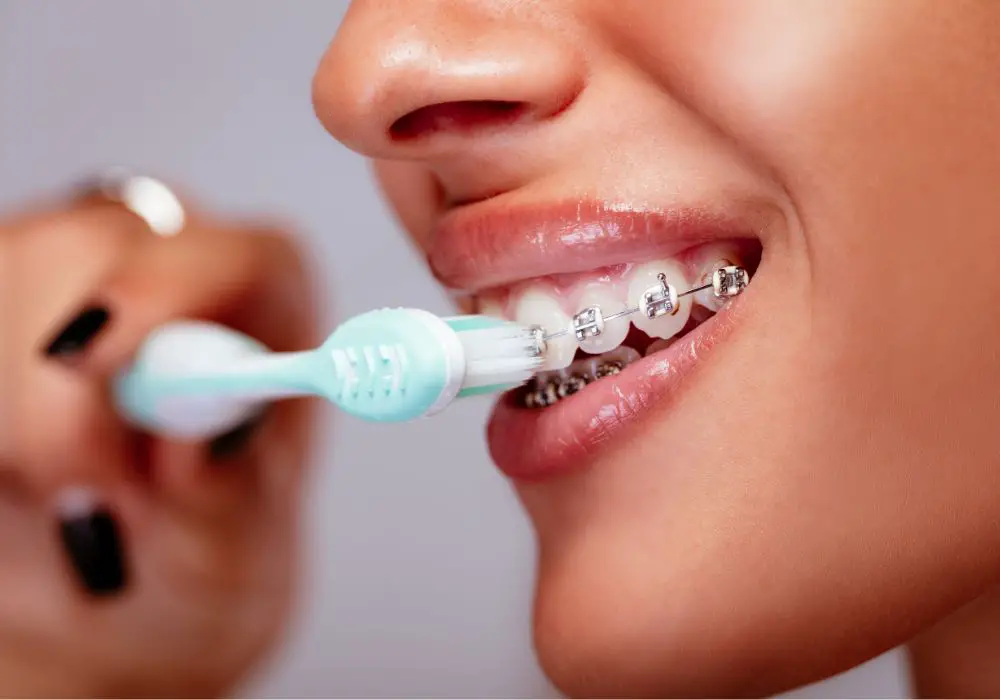
Orthodontists recommend brushing at minimum twice per day and ideally after every meal when wearing braces. Here is a typical recommended brushing schedule:
- Brush thoroughly in the morning after eating breakfast to clean your teeth before starting the day. Be sure to brush your tongue too.
- Brush your teeth again after eating lunch to remove any food particles before they have time to break down into plaque acids.
- After dinner, it’s critical to brush again and inspect that no food is trapped. Nighttime is the longest period between brushing, so you want your mouth as clean as possible.
- If you have a snack after school or work, be sure to brush after eating it as well to clear away any lingering sugars or carbs.
- Right before bed, do a quick brushing session to protect your teeth overnight while you sleep.
This involves brushing about four times a day at minimum. Some orthodontists even recommend brushing after smaller snacks like an apple, crackers, or midafternoon coffee break to prevent plaque accumulation as much as possible. The more often you can remove food debris and plaque, the better.
Proper Brushing Technique Around Braces
In addition to frequency, using proper technique ensures you thoroughly clean all tooth surfaces:
- Use a soft-bristled toothbrush, either manual or electric, to avoid irritating your gums during brushing. Electric toothbrushes are great for maneuvering around wires and brackets. Replace your brush every 3-4 months when bristles become frayed.
- Apply fluoride toothpaste to strengthen enamel and prevent mineral loss from plaque acids. Make sure to brush for a full 2-3 minutes each session, setting a timer if needed. Rushing through won’t remove all plaque.
- Tilt your toothbrush at a 45 degree angle where your gums meet teeth. Gently brush using vibrating motions rather than sawing back and forth. Start below the gumline and brush down each tooth.
- Take extra time focusing on the plaque-prone areas around braces. Ensure bristles contact all sides of each bracket, wire, and band. Angle your brush to access spots around braces.
- Brush all tooth surfaces – outer surfaces, inside surfaces where your tongue touches, biting surfaces, and where teeth touch each other.
- Follow up with floss or interdental cleaners to remove any plaque between teeth and under wires.
With braces, proper brushing technique is just as crucial as brushing frequency for reducing plaque buildup and potential complications.
Additional Tips for Cleaning With Braces
Here are some supplemental cleaning tips for people with braces:
- Use an oral irrigator or water flosser to flush out food debris and plaque.
- Rinse daily with an antiseptic, alcohol-free mouthwash to kill bacteria between brushing.
- Chew xylitol gum after meals, which helps clean teeth and neutralize plaque acids.
- Limit consumption of staining foods and drinks like coffee, berries, tomato sauce, tobacco, red wine, etc. Rinse with water after consuming them.
- Get professional cleanings every 3-6 months to remove hardened tartar (calcified plaque).
With diligent oral hygiene habits, you can keep your mouth healthy and braces crystal clean!
The Impact of Poor Brushing on Orthodontic Treatment
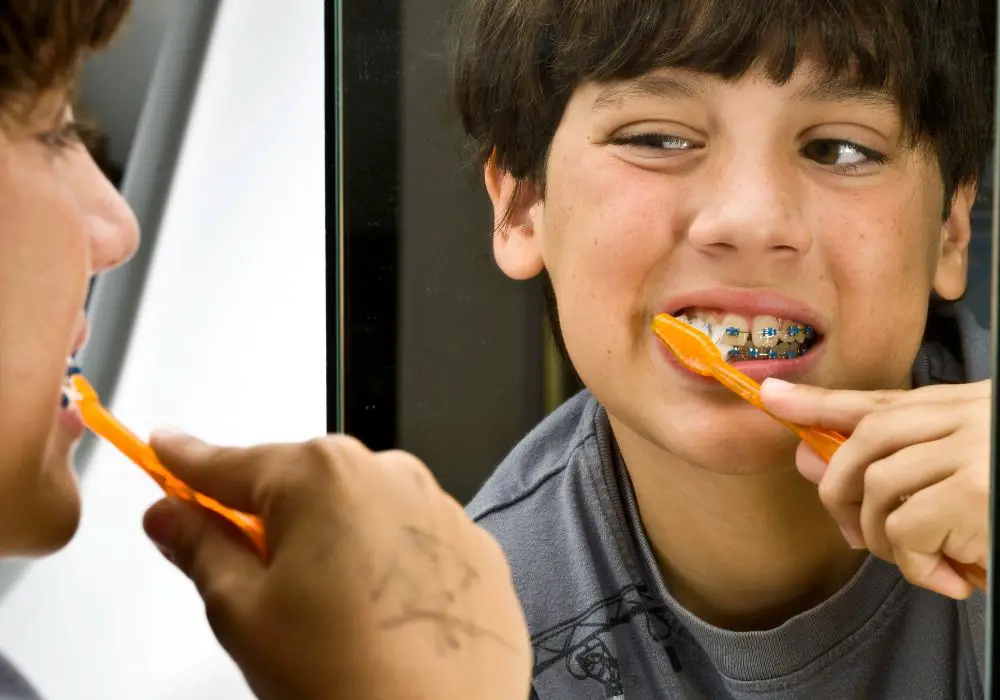
If you slack on oral hygiene while wearing braces, it negatively affects your orthodontic treatment outcome and duration. Here are some of the problems poor brushing can cause:
1. Extended Treatment Time
Inadequate brushing leads to excessive plaque buildup around orthodontic brackets. This plaque creates friction that prevents brackets from sliding along wires smoothly as teeth shift. With inadequate space between bracket and tooth, teeth won’t be able to move into proper alignment.
This means your orthodontic treatment will inevitably take longer with poor oral hygiene. Dentists may even put active treatment on hold until you improve home care. They don’t want to keep applying forces and causing you discomfort if plaque prevents proper tooth movement anyway.
To achieve desired results in the shortest treatment time, consistent brushing and flossing are musts in order for braces to work effectively. Removing debris improves the pace of tooth movement.
2. Permanent White Spots
Failing to neutralize plaque acids through brushing causes white spot lesions – the earliest stage of enamel decay. This mineral loss shows up as chalky, dull spots on your enamel around brackets or bands. Without intervention, they become etched into the surface.
These unsightly white spots remain permanently even after braces come off, marring your smile. Proper brushing strengthens and remineralizes enamel to resist acid damage before it’s too late. Catching the decay early is key.
3. Gum Disease and Bone Loss
Plaque that spreads below the gumline triggers an inflammatory response in gums. They become puffy, red, and prone to bleeding – called gingivitis. Without daily brushing, gingivitis worsens into periodontitis as connective tissue and bone erode. In serious cases, significant bone loss can lead to loose teeth.
This gum disease is irreversible, so maintaining oral hygiene is crucial. Brushing and flossing removes bacterial plaque before your gums are seriously impacted. Don’t allow gingivitis to advance.
4. Cavities Around Braces
Particularly concerning are actual cavities – permanently damaged holes in tooth enamel – that form adjacent to orthodontic brackets or bands during treatment. Frequent brushing and flossing prevents the decay that causes cavity formation.
If cavities go untreated, the damaged areas around braces weaken teeth and make fractures more likely, even after appliances come off. Extensive untreated decay may eventually require teeth extractions in severe cases.
5. Stained Teeth
Without prompt brushing, foods and drinks that stain teeth are allowed to set into the enamel surrounding brackets. This causes unsightly discoloration that may persist indefinitely even after you complete orthodontic treatment.
Common staining culprits are coffee, tea, soda, red wine, tobacco products, berries, tomato sauce, curry, and soy sauce. The longer these substances contact your enamel, the more the pigments penetrate and darken teeth.
Careful brushing right after consuming stain-causing products prevents ugly staining and protects your bright smile. Don’t let stains sabotage your braces progress.
Clearly, poor oral hygiene has many detrimental orthodontic effects. The plaque buildup leads to health issues that complicate treatment. Make brushing and flossing after every meal a habit to prevent problems.
When Is Brushing Just Once Okay With Braces?
Generally, once daily brushing is insufficient to control oral bacteria and plaque when you’re wearing braces. However, there are a couple scenarios where brushing only once may be permissible temporarily:
While Traveling
When you are traveling and not able to stick to your usual oral hygiene routine, brushing once a day minimally is understandable. For example, it’s difficult to brush thoroughly after meals during a long flight or road trip.
Do your best to rinse with water and chew gum after eating. Pack dental supplies to brush and floss at least once when you stop for the night. Get back to your normal oral hygiene routine as soon as you reach your destination.
On Sick Days
If you feel lousy with an illness involving fever, body aches, or fatigue, don’t overexert yourself. Just focus on brushing once or twice daily if you are too wiped out to manage the recommended 3-4 times that day. Rinsing with mouthwash can also help between brushing.
However, return to your regular, more thorough brushing schedule as soon as you start feeling better. Never use sickness as an excuse to slack on oral hygiene for more than a day or two.
Aside from extenuating circumstances like travel or illness, skipping brushing sessions is risky and allows bacteria populations to surge unchecked when you have braces. Stick as closely as possible to brushing after meals.
Maintaining Proper Oral Hygiene With Braces
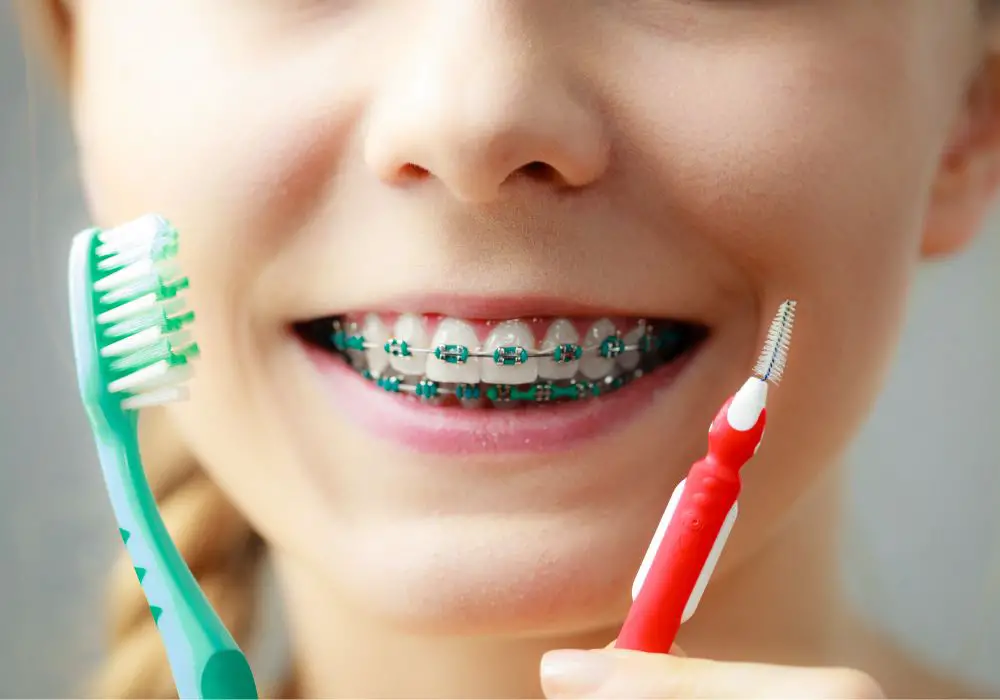
To keep your mouth healthy during orthodontic treatment, make adjustments to prioritize thorough oral hygiene:
- Brush teeth gently yet thoroughly after every meal for 2-3 full minutes each session. Set a timer if needed.
- Angle bristles 45 degrees towards gums. Assure bristles contact all surfaces of brackets and wires.
- Focus extra attention on plaque-prone areas surrounding orthodontic hardware.
- Use new soft bristle toothbrush every 3-4 months before bristles fray. Electric options also clean braces well.
- Apply fluoride toothpaste to protect enamel from plaque acids. Avoid abrasive whitening toothpastes.
- Floss carefully between teeth and under wires with floss threaders to clear plaque.
- Rinse daily with antiseptic mouthwash like Listerine between brushing.
- Limit consumption of staining foods and drinks like coffee, tea, soda, red wine, tobacco products, etc.
- Get professional cleanings every 3-6 months to remove hardened tartar.
With some adjustments to prioritize oral health, your braces treatment can stay on track and complication-free. Be diligent about proper brushing and flossing.
FAQ About Brushing With Braces
Here are answers to some common questions about brushing when you have braces:
How many times a day should you brush with braces?
With braces, it’s recommended to brush after every meal – roughly 4 times daily minimum. Brushing frequently removes food debris and plaque before they can cause damage.
What kind of toothbrush works best for braces?
Use a soft-bristled brush, either manual or electric. Electric options are great for cleaning around all the brace components. Just take care not to scrub too hard.
How long is enough time to brush with braces?
To fully remove plaque around brackets and wires, brush for a full 2-3 minutes each session. You can set a phone timer if needed. Don’t cut brushing time short.
What tooth surfaces should I focus on with braces?
Carefully brush the front, back, top, sides, and chewing surfaces of all teeth. Pay extra attention to areas around orthodontic hardware where plaque loves to collect.
Can I just use mouthwash instead of brushing with braces?
No – mouthwash alone is not enough for brace wearers. The physical scrubbing action of brushing is critical for removing plaque buildup around your brackets. Use mouthwash as a supplement to brushing and flossing.
Don’t cut corners on oral hygiene during orthodontic treatment. Brushing properly multiple times daily keeps your smile healthy and braces working their best!
Conclusion
Getting braces to straighten your teeth is an exciting journey! But keeping your teeth sparkling clean with braces requires extra diligence and care. Brushing just once daily simply doesn’t cut it for controlling plaque buildup and bacteria when you have orthodontic appliances.
To protect your oral health and treatment progress, experts recommend brushing gently after every meal for 2-3 full minutes. This ensures food debris and plaque are removed before they can cause tooth decay, gum inflammation, stains, and other problems. Flossing properly and using supplemental tools like mouthwash also helps maintain cleanliness.
With some relatively small adjustments to your oral hygiene routine, your orthodontic treatment can stay on track and complication-free. Don’t let poor brushing prolong your treatment time or create unnecessary dental work. Keeping your teeth plaque-free ensures your smile will be healthy and beautiful both now and after you complete braces. So be sure to grab your toothbrush after every meal—your teeth will thank you!

